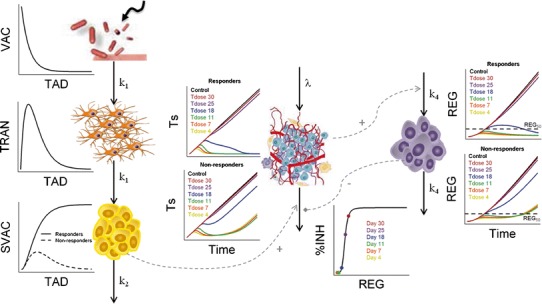Fig. 2.

Schematic representation and population performance of the mathematical model selected. After VAC administration and through a transit compartment (TRAN), the vaccine triggers a signal (SVAC) able to decrease tumour size (Ts). Two different populations (responders and non-responders) at the level of the SVAC elimination were identified. An inhibition of vaccine efficacy induced by a regulator compartment (REG) controlled by tumour size was detected. The behaviour of the different model compartment over time for both populations, along with the percentage of inhibition (%INH) induced by REG over k3 versus the amount in the regulator compartment under no vaccine administration, and highlighting the REG amount at relevant time points, are presented. k 1 first-order rate constant controlling vaccine elimination and transit between compartments; k 2 first-order rate constant accounting for SVAC degradation; λ zero-order rate constant of tumour growth; k 3 the vaccine efficacy second-order rate constant; k 4 the first-order rate constant controlling the regulator compartment dynamics; REG 50 amount in the regulator compartment needed to inhibit vaccine activity by a half; γ the shape of that inhibitory process. TAD time after dose (vaccine) administration. Tdose day of vaccine administration
